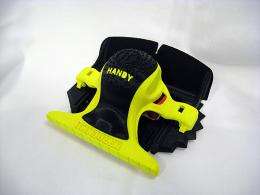Need it, print it

Imagine being able to design a new aircraft engine part on a computer, and then being able to print it. Not the design – the actual part. And not just a lightweight, nonfunctional model, but an actual working part to be installed in an engine.
The University of Dayton Research Institute was awarded $3 million from the Ohio Third Frontier today to provide specialized materials for use in additive manufacturing – the science of using computer printers to create three-dimensional, functional objects. The University of Dayton Research Institute will work with program partners, Stratasys of Eden Prairie, Minn., and PolyOne and Rapid Prototype Plus Manufacturing Inc. (RP+M) of Avon Lake, Ohio, to develop aircraft-engine components for GE Aviation – who also collaborated on the program proposal – as well as parts and components for ATK Aerospace Structures, Boeing, Goodrich, Honda, Lockheed Martin and Northrop Grumman.
While traditional paper printers use a moving toner cartridge head to form lines of text, adding row upon row of toner as the paper moves through the printer, 3-D printing works much the same way. Instead of toner, however, a free-moving printer head precisely deposits layer upon layer of plastic or other material to create a solid object from the bottom up.
3-D printing technology has existed for about 20 years, but additive manufacturing in its current form is only about five years old, said Brian Rice, head of the Research Institute's Multi-Scale Composites and Polymers Division and program lead for the Third Frontier-funded Advanced Materials for Additive Manufacturing Maturation program.
"The difference is that 3-D printing is known in the industry as being used for nonfunctional prototypes or models, while additive manufacturing is being used to create usable parts for industries such as aerospace, energy, medical and consumer products," Rice said.
Additive manufacturing, which made headlines this month in the Wall Street Journal and USA Today and was named number one in Aviation Week & Space Technology magazine's May list of "Top Technologies to Watch," is a rapidly growing manufacturing technology being touted for its cost savings and waste reduction. By 2015, the sale of additive manufacturing products and services worldwide is expected to grow to $3.7 billion from $1.71 billion in 2011, according to independent consultants Wohlers Associates.
There are a number of advantages to additive manufacturing over traditional manufacturing, such as injection molding or machining, Rice said.
"Cost savings is a major benefit, because there are no molds or tooling needed to fabricate parts. With traditional manufacturing, every time you want to make even a slight change to the design of what you are making, you have to retool or make an entirely new mold, and that gets very expensive. With additive manufacturing, you can change your design as often as you want simply by changing the design on your computer file. "You can't make complex parts with injection molding," Rice added. "And because you can print an entire part in one piece with additive manufacturing, instead of welding or attaching separate components together as in traditional manufacturing, the finished part is stronger."
Additive manufacturing holds additional benefits, said Jeff DeGrange, vice-president of Stratasys, which owns an industrial line of additive manufacturing machines that will be used to print components for end users.
"It's better for the environment because it reduces waste," DeGrange said. "With additive manufacturing, you only use as much material as you need for the part you're printing. But with machining, you're shaping objects by removing material from a larger block until you have the desired form, so there is a good bit of wasted material."
Additive manufacturing eliminates the need for bolts, screws and welding and, in some cases, reinforced polymers can be used to replace heavier materials, DeGrange added.
"Lighter parts mean greater fuel efficiency in vehicles and aircraft that use them. Another advantage is the cost savings that comes from a print-as-needed process, because you don't need to ship parts or find a place to warehouse them," he said.
3-D printers can use polymer, metal or ceramic feedstock, but our focus will be on polymers, which is already a major manufacturing industry in Ohio, according to Rice.
"UDRI has developed a highly specialized nanomaterial that will reinforce the polymer feedstock, giving the finished product greater strength and stiffness than nonreinforced polymer. It will also make the polymer electrically conductive," he said.
PolyOne will scale-up the polymer feedstock needed for mass manufacturing, Stratasys will support the inclusion of new materials in their additive manufacturing systems, and RP+M will use its expertise in additive parts manufacturing to work with Stratasys to print and supply parts to end users, Rice said.
"We've created an entire supply chain designed to create Ohio jobs," Rice said. "We expect this program to result in the creation of 30 high-tech jobs in Ohio during the first three years and 85 jobs after five years."
The Research Institute will use part of the Third Frontier award to purchase a 3-D printer to demonstrate the technology, and the University of Dayton School of Engineering, which recently purchased a similar machine, will provide hands-on opportunities for engineering students to become involved.
"They will focus on research into new materials and innovation in additive manufacturing," Rice said. "It's a boost for our program, and it will also provide those students with skills that will help them secure high-tech manufacturing jobs after graduation."
Provided by University of Dayton
















